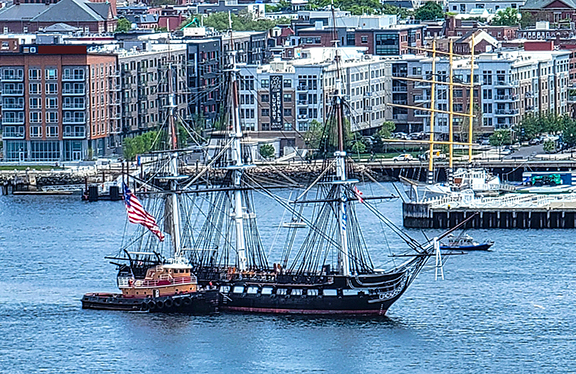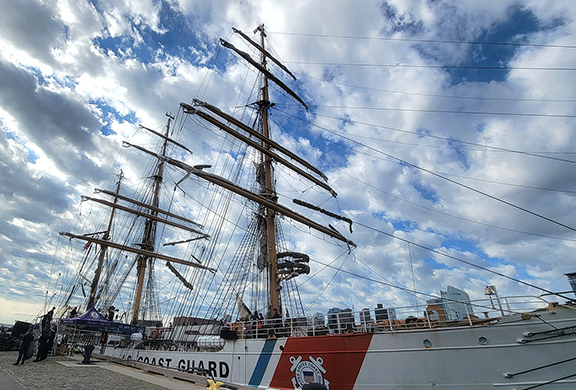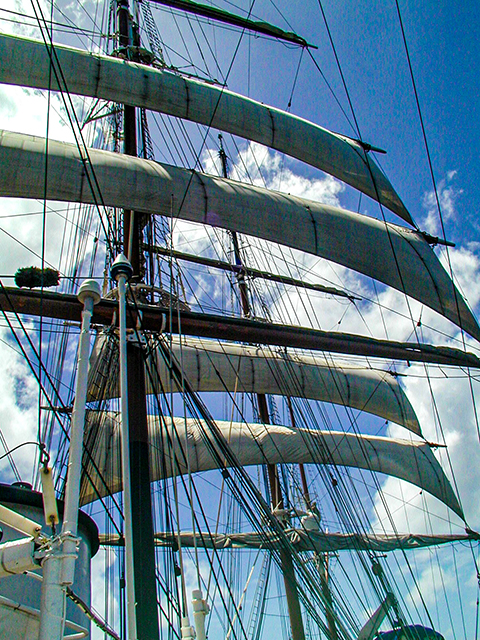By Corey Sandler
My office window overlooks Boston harbor, a bird’s-eye view of an historic patch of the North Atlantic that includes the location of the Boston Tea Party, the remains of the old wharves from which the city built its fame and fortune, and around the corner the permanent dock of the oldest commissioned sailing vessel in the U.S. Navy, the U.S.S. Constitution.
Constitution was launched from a dockyard in 1797 in what is now Boston’s North End, also in view from my window. Mostly constructed of live oak, as much as seven inches thick; Paul Revere made the copper sheathing for the hull and forged copper spikes and bolts to attach her planks.
Several times a year Constitution is brought out from her berth and taken on a tour of the harbor, usually stopping to let loose a ceremonial salvo at Fort Independence on Castle Island at the outside of the harbor and again in front of the Coast Guard station in Boston near where she was constructed.
As I began writing this blog, I looked up and spotted her passing through the harbor once again.


Today she relies mostly on assistance from tugboats, last moving under sail in August 2012 to commemorate the 200th anniversary of her victory over Guerriere during the War of 1812. It was during that successful battle off the coast of Halifax, Nova Scotia where she earned her nickname “Old Ironsides” after her sturdy oak planking withstood cannonballs from the British vessel.
Constitution saw service against the Barbary pirates of North Africa, the War of 1812, and as a training vessel and ambassador ship including a circumnavigation of the planet in the 1840s and a three-year 90-port tour of the United States in 1934 after a decades-long fundraising effort that mostly collected coins from schoolchildren to pay for upkeep and restoration.
It is still a thrill to see the majestic three-masted heavy frigate, 304 feet in length from bowsprit to spanker, her mainmast standing 220 feet tall. I walk over to visit every few weeks to Charlestown to see her at the dock,.
Constitution is crewed by U.S. Navy personnel and is used for training and exhibition.
But a few weeks ago I caught glimpse of another large sailing vessel moving through the harbor, also flying the American flag.
The Coast Guard Cutter Eagle sailed into the harbor, below my window, stopping to salute the Coast Guard station, and then continued to Charlestown where she tied up at the end of the same pier that is home to her older cousin Constitution.


USCGC Eagle is a training vessel for the Coast Guard, carrying cadets and officer candidates from that branch’s academy. Eagle is just slightly smaller than her much older cousin; 295 feet long from stem to stern, with her foremast and mainmast standing 147 feet tall with a slightly shorter mizzenmast aft of the main.

Eagle has a steel (not iron, not oak) hull and was launched in 1936 as a German naval training vessel; it came into American hands as part of World War II reparations.
This year, for the first time, both ships are under command of a female officer.
About 15 years ago we forged our own connection to USCGC Eagle when we sailed in the Caribbean aboard another venerable ship, Sea Cloud. She is larger than the two old naval ships in this post: 360 feet in length.

Sea Cloud was built for Marjorie Merriweather Post in 1931, at one point serving as the unofficial residence of Post and her husband Joseph E. Davies, the second American ambassador to the Soviet Union. The ship was tied up in the River Neva in St. Petersburg in part because Post preferred its luxuries to those of Soviet Moscow.
During World War II, Post allowed the U.S. Navy to charter the ship for $1 per year and it served as a U.S. Coast Guard Cutter weather observation ship, home-based here in Boston. Today Sea Cloud is back in private hands, carrying cruise guests mostly in the Caribbean and the Mediterranean.
It was on one of those voyages that we spent some time with Sea Cloud‘s captain, Richard “Red” Shannon. We learned that he had retired from a career in the Coast Guard, and that one of his postings had been as sailing master of the Coast Guard Cutter Eagle.
On that voyage we met up with the very modern sailing vessel Wind Surf, part of the Windstar cruise fleet. The world’s largest passenger-ship sailing vessel at 617 feet including bowsprit, it has five aluminum masts and a computer-controlled mechanism to raise, lower, or furl its high-tech sails. Below decks there is also an engine to drive a propeller when that was needed or desirable; to be fair, both the Eagle and Sea Cloud have a similar arrangement.

I asked Captain Shannon what he thought of the fancy Windstar vessel.
With a practiced pause, he said, “Well, I expect the sails don’t slow her down much.”
Photos and text copyright Corey Sandler. To obtain copies or otherwise use images, please contact me through my website at www.coreysandler.com
